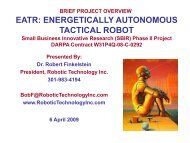eatr: energetically autonomous tactical robot - Robotic Technology Inc.
eatr: energetically autonomous tactical robot - Robotic Technology Inc.
eatr: energetically autonomous tactical robot - Robotic Technology Inc.
You also want an ePaper? Increase the reach of your titles
YUMPU automatically turns print PDFs into web optimized ePapers that Google loves.
station uninterrupted for over five years to perform intelligence, surveillance,<br />
reconnaissance (ISR), and communication missions over an area of interest). Likewise,<br />
there is a need for Unmanned Ground Vehicles (UGVs) to perform long-range, longendurance<br />
missions without manual or conventional refueling (however, unlike for<br />
UAVs, solar energy alone is insufficient for most UGV energy requirements).<br />
A <strong>robot</strong>ic vehicle’s inherent advantage is its ability to engage in long-endurance,<br />
tedious, and hazardous tasks, such as Reconnaissance, Surveillance, and Target<br />
Acquisition (RSTA) under difficult conditions, without fatigue or stress. This advantage<br />
can be severely reduced by the need for the <strong>robot</strong>ic platform to replenish its fuel supply.<br />
Example long-range, long-endurance missions for <strong>robot</strong>ic ground vehicles include:<br />
RSTA missions in the mountains and caves of Afghanistan and Pakistan; search<br />
missions for nuclear facilities and underground bunkers in rogue nations; special<br />
operations and counter-insurgency; patrolling remote borders; homeland security;<br />
serving as nodes in distributed and remote command, control, communications, and<br />
intelligence (C3I) networks; and serving as remote, mobile sensor and target tracking<br />
platforms in ballistic missile defense systems. Either strategically or <strong>tactical</strong>ly, longrange,<br />
long-endurance UGVs can work cooperatively with – and complement –<br />
long-range, long-endurance UAVs.<br />
TECHNICAL OBJECTIVES<br />
The initial objective is to develop and demonstrate a proof-of-concept system.<br />
Demonstration of a full operational prototype is the objective for a Phase III<br />
commercialization project.<br />
The project will demonstrate the ability of the EATR to: (1) identify suitable biomass<br />
sources of energy and distinguish those sources from unsuitable materials (e.g., wood,<br />
grass, or paper from rocks, metal, or glass); (2) spatially locate and manipulate the<br />
sources of energy (e.g., cut or shred to size, grasp, lift, and ingest); and (3) convert the<br />
biomass to sufficient electrical energy to power the EATR subsystems.<br />
The EATR system has four major subsystems: a <strong>robot</strong>ic mobility platform<br />
subsystem; an <strong>autonomous</strong>, intelligent control and sensor subsystem; a <strong>robot</strong>ic arm and<br />
end effectors subsystem; and a hybrid external combustion engine subsystem.<br />
<strong>Robotic</strong> Mobility Platform<br />
The <strong>autonomous</strong> <strong>robot</strong>ic mobility platform may consist of any suitable automotive<br />
vehicle, such as a <strong>robot</strong>ically-modified High Mobility Multi-Wheeled Vehicle (HMMWV),<br />
or a purely <strong>robot</strong>ic vehicle. The platform provides mobility for the mission and mission<br />
payload, and, for our proof-of-concept purposes, accommodation for the EATR<br />
subsystems.<br />
2





